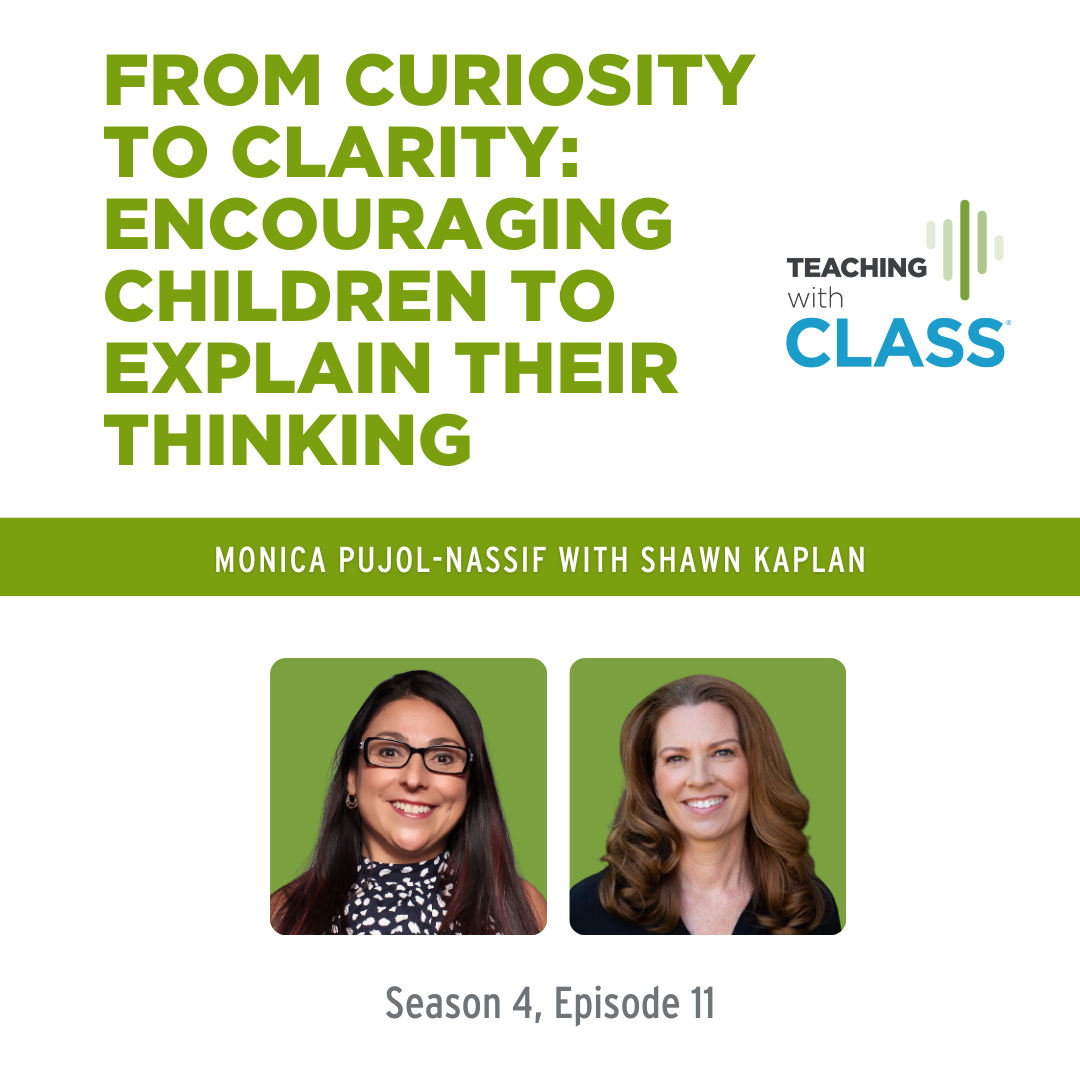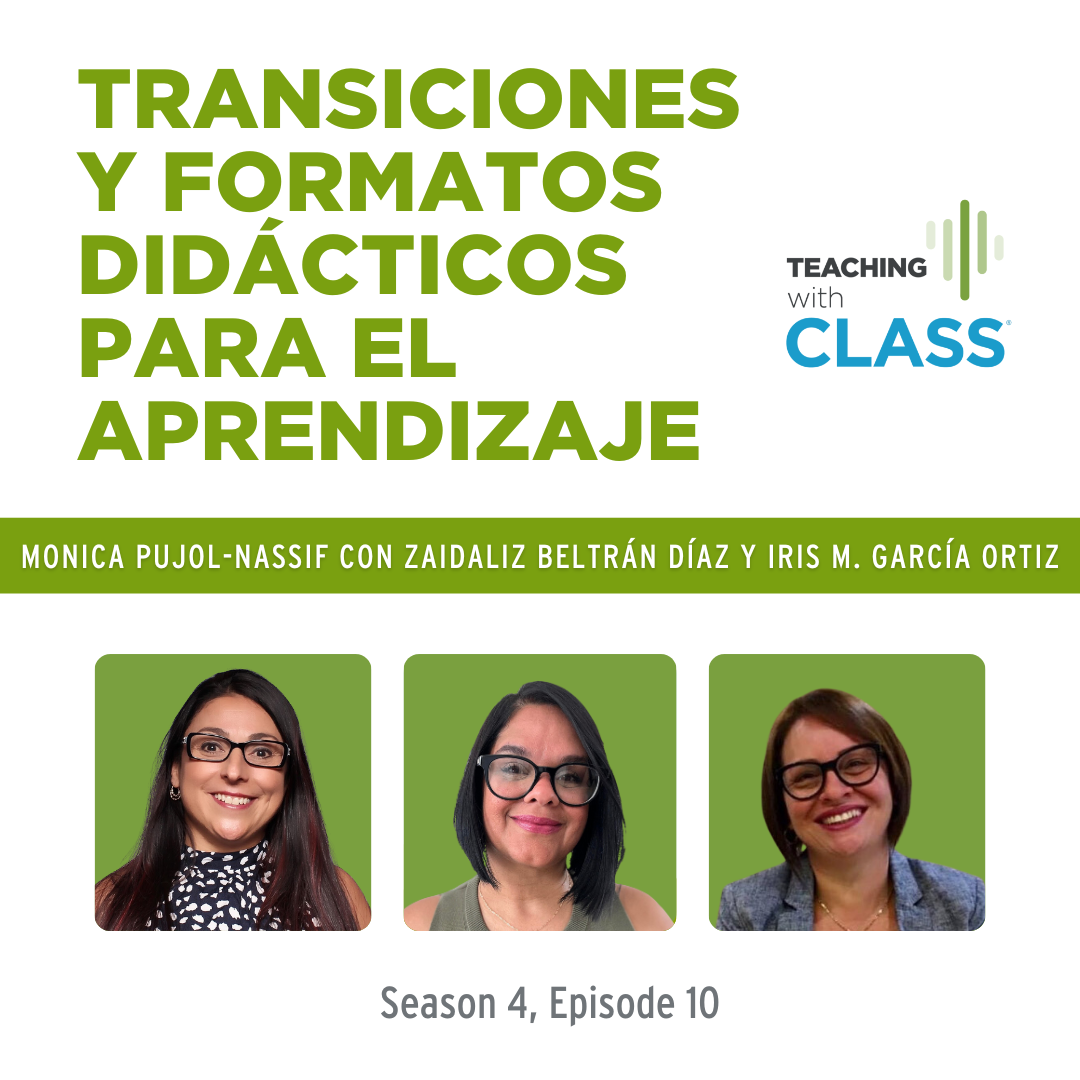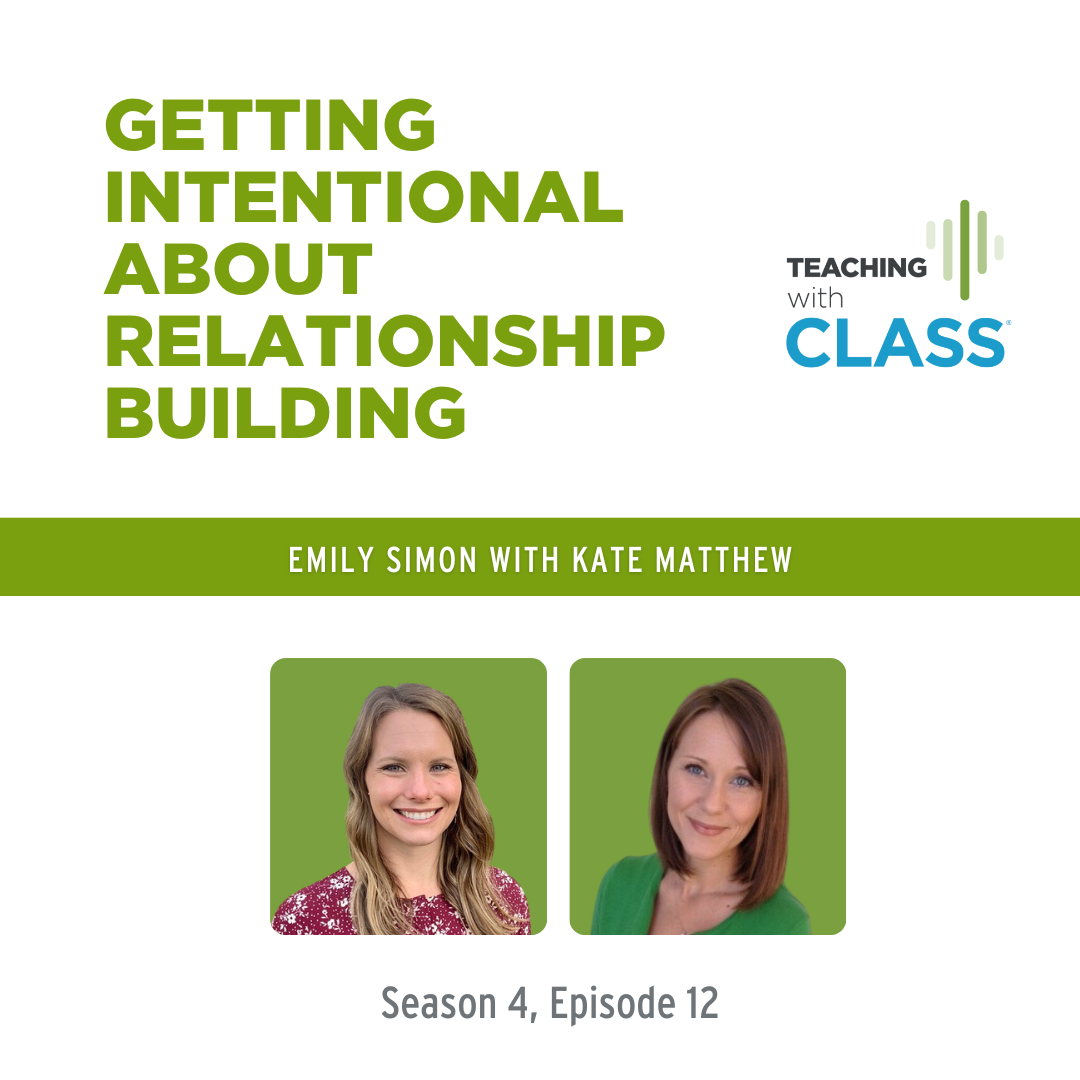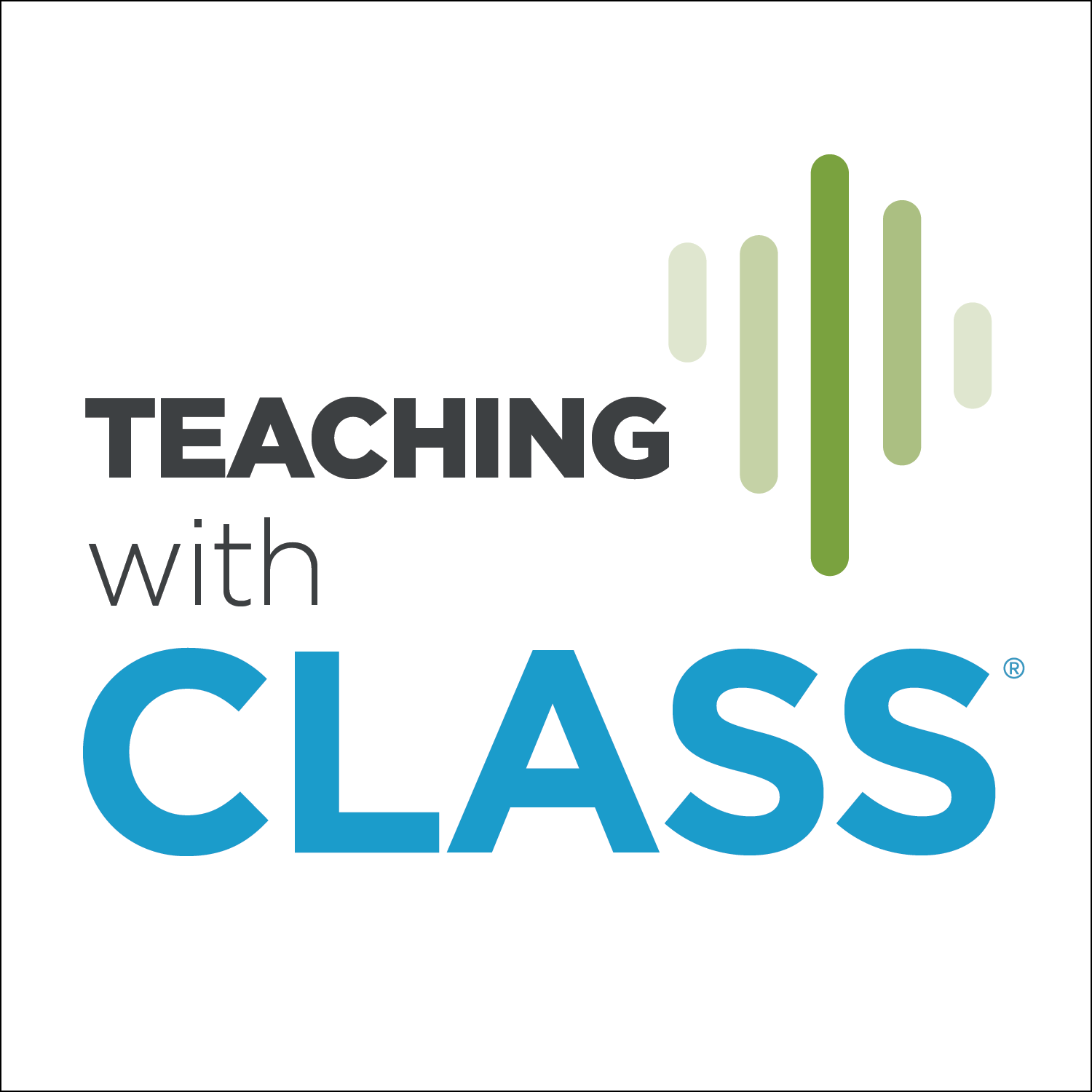Episode Transcript
Monica: Hello, and welcome to the Teaching with CLASS podcast, the podcast that gives you quick, actionable tips to easily implement in your classroom. I'm your host, Monica Pujol-Nassif.
Today, we are going to talk about curiosity to clarity, encouraging children to explain their thinking. For this, I have my friend, Shawn Kaplan, a colleague, class specialist here Teachstone, to share with you her expertise. Shawn, let's start with getting to know you a little bit. Tell us a little bit about yourself.
Shawn: I've been in early childhood education for a little over 30 years, starting and moving through infant care, toddler care, preschool, classroom work, administration work, coaching, training, and have the amazing opportunity to be here now in this podcast opportunity, working and supporting all things Teachstone, and doing trainings for Teachstone as well.
Monica: Thank you, Shawn. We couldn't be happier to have you in the team and today in the podcast with me. Teachers, get ready. This is going to be super interesting and super fun talking about explaining and thinking. Let's start with that. Can you please tell us, what does it mean to explain their thinking?
Shawn: When we talk about having children explain their thinking, it really is that chance and opportunity to pose questions, asking children to explain, really articulate, what is it that's running through their mind? What is their thought process that's taking place right now?
As they explain their thinking and work to articulate that back, it's giving them the opportunity to have those light bulb moments and put all other kinds of language development and cognitive thinking power into practice. It's a rich opportunity to help children really move through those cognitive higher order thinking skills.
Monica: Excellent. It's helping them talk to us about what is in their mind and guiding that cognitive skill happening. Let's talk about that. How does explaining their thinking will help children develop cognitive skills?
Shawn: I like to attach that akin to what happens in our own mind, too, when we go to explain something back, or somebody asks us a question about why we've done something, or why we always do certain things the same way.
When we ask children those same types of questions—for example, tell me why you decided to use those blocks in that building, that tower—it requires the child to pause for a thought. As they start to articulate in their own mind first, those are those higher order thinking skills that are starting to take place. It's exercising that cognitive muscle that they have, and then that becomes the translation out into expressive language. They need those opportunities to be able to stop for pause and get that cognitive muscle really flexing in their head.
Monica: When you're saying that, I'm thinking not always, or in the beginning we might not get answers when we are asked those questions. Is there no use to being asked those kinds of questions? But with practice, persistence, encouragement, and purpose, they will set a learning on how to answer the question.
Shawn: Absolutely. I think we always want to remember, too, the power of the question is still getting a child to think. Even if we're not getting the verbal response back, they're starting to slowly build that cognitive muscle in their mind, because it gives them room. When we ask a question and pause, it gives them the room to start to build that muscle.
If we're not getting those verbal answers back, there's still an opportunity to potentially ask an additional question that might be a little bit smaller, a bite-sized question that will then get them to provide that verbal response that you will be able to continue to build on.
I would never ask somebody to lift 250 pounds straight off the bat on the first day in the gym, so we might lift a smaller weight at first. Those are those bite-sized questions to build their ability to ask the bigger ones.
Monica: I love it. The power of the question; pause to let them process. I love the small questions in the beginning and build on them.
As we think of this, there are so many different moments in the day that children are in the classroom with peers and their educators. What are ideal moments of the day when teachers and children can engage in these kinds of interactions?
Shawn: I think a lot of educators are out there wondering, when and how do I ask these questions? When and how do I provide these opportunities? Days that are so filled with responsibilities and so much going on, do I really have time to do this? It's the other side of, how do I identify those opportunities at the moment?
One of the powerful ways that educators can start to take advantage of those more ideal moments is to think about what are the spaces in their routine and the times of day that feel the easiest for them? Is it when it's one on one? Is it a small group when the educators are the most relaxed and comfortable in those interactions, thinking about what's taking place at that time and prepping a question or two to have in their back pocket? I like to call them fill in the blanks.
We can have a question starter that the educator can then use to fill in the blank. For example, ‘why did you decide to,’ and then that can fit at various times of the day. Or ‘tell me why you think that,’ and then they can fill in the rest of it. Whatever's happening in that moment, it gives the educator that power of feeling a little more prepared and ready.
Monica: My question to go to is, how do you know that? I do know we've had this question before from teachers. I love how you said—go to the moment that you're the most comfortable, that you can start making this push of thinking, asking them to explain their thinking. But they say, I don't have time to do that during lunchtime or during transitions. Can you think of explicit examples to give teachers that are listening to us on this episode that they can ask during lunchtime and transitions?
Shawn: I love mealtime opportunities. Again, if we go back to thinking about how we are as adults, what is the most valuable time that we have conversations with the people that we love and spend time with? It's when we're eating, it's when we're out to dinner. It's around those holiday celebration meals that we have the grandest conversations.
This is no exception in the classroom. This is a powerful opportunity to be able to engage in dialogue and ask those powerful questions that get children to explain their thinking back. We can start off with a simple conversation around what we're eating.
As we watch and notice—I always love this part of being in the classroom—meals and snacks were such a tremendous joy to be able to watch the patterns in the way that children eat, and they all eat a little bit differently. If you're watching how your children are eating what they choose to eat first, for example, there is an opportunity for prompting thought process questions. Tell me why you always eat your fruit first, for example. That is going to, again, give that pause, allow the child to think about it, and then they'll have an opportunity to explain.
They might answer briefly by saying, I like it, it's yummy because, and then we can go ahead and build on some. I noticed you like to eat your chicken, your meat, or your protein last. Why is that? Giving them just opportunities to talk about the things that are naturally occurring at a meal time, powerful opportunity.
Monica: Excellent. Can you think of something about transitions? That's a big one too.
Shawn: Transitions can oftentimes feel like a hectic time of day for educators, because there's a lot that you're trying to move through. You're trying to get from point A to point B literally, and making sure that everybody is along the way in that transitional process. I think leaning into those fill in the blanks, watch again. Power of observation of what your children are doing, watch how they're moving through that transition, and ask those prompting thought process questions.
Why did you decide to put maybe these books away first as we're transitioning, putting our books away and then meeting to hand wash, to go outside, or whatever it might be? Watching and observing what children are doing are going to fuel those questions for you to ask them. It's genuine curiosity. Tell me why you decided to do something. Why do you think that?
We can also set ourselves up as educators to create these opportunities to ask prompting thought process questions. I like to explain this and talk about this in light of playing volleyball. When you think about a volleyball game, one player will set the other one up. You toss that ball in the air, and you've got that next player ready to hit. You can do that as an educator with your students. If you're struggling to find those questions, ask one first, set the stage.
You might say to children, what do you think would be the quickest way for us to transition from mealtime to getting our jackets on? Set them up with a question that they need to answer, and then your prompting thought process question comes right after that.
A child might say, the fastest way to get there is to hop like a kangaroo, for example, and then you can ask that prompting thought process question. Why do you think kangaroos are the fastest animal or the fastest way for us to get there? You can set the stage. You can set it up for yourself to be able to ask more of these prompting thought process questions, too.
Monica: I was going to ask, how can they see reminders? What you just said is so clear. So plan, and then follow-up with that prompting thought processes. You also mentioned a little bit of when they say, I don't know, my mom said, or my dad said. How can you just persist so that the brain can use it to go beyond that? You did talk about those bite-sized questions. What else can teachers do to push it, to stick to it, and push that thinking?
Shawn: I think there's another layer here for educators to trust themselves with and be mindful of. That is, if we go back to those bite-sized pieces in that analogy of thinking about, we wouldn't walk into the gym on the first day and lift hundreds of pounds. I'm going to start off with three pound weights. That's what I'm going to start off with, and then I'll graduate to the five pound weights and so forth.
As we think about those bite-sized pieces and the why behind those types of answers, because my mom told me, or I don't know. I don't know if it is a common phrase these days, even amongst adults. The more we understand the why behind those answers, the easier it's going to be for us or for the educators to be able to go ahead and add that bite-sized question.
If we think about children's exposure, how much opportunities have they had? Have they ever gone to the gym, essentially? If not, then that gives us that reminder. They're giving us a lot of information when they respond.
When we hear children respond with, I don't know, or maybe even just a shrug of the shoulders and no verbal response, that's them telling us, I have never been to the gym. We want to offer that bite-sized question. Let's give them just the three pound weight. Pull back and ask a simplified question. We might ask a yes or no question first to warm them up a little bit. As that cognitive muscle starts going, then we can reintroduce that deeper, prompting thought process question.
Monica: Absolutely. You saying that brought me to the next question. We're talking about this behavior. Teachers, listeners out there, you have identified that we're speaking about the quality of feedback.
I want to invite Shawn to share, when you do this indicator of prompting thought processes, asking children to explain their thinking, how will this connect to the other four indicators of quality of feedback? How can scaffolding play a role here, the feedback loops, providing information, and encouragement and affirmation?
Shawn: That's the opportunity to set yourself up again. When you get those responses, it's a perfect opportunity to say, okay, I need to scaffold a little bit here. Let me maybe give a little bit of a hint. We ask a question to a child.
Let's say, for instance, you're talking about the differences between animals that live on land and animals that live in the water. A child says that a whale lives in the water. I know, Monica, you said one of your favorite questions is, how do you know that? We respond to that statement from a child that a whale lives in the water with the question, how do you know that? They give us, my mom told me, or I don't know, then we can scaffold a little bit.
We might say, well, point to the chart of the pictures that we've had of all the different animals that live in the water versus on the land, and give them a little hint. What else does this whale have that's similar to all the other animals that are already in the water? A little bit of scaffolding. Getting them to connect those dots.
Our feedback loops that we have with children and the persistence that we bring to the table of asking additional questions, those questions can be yes or no closed-ended, bite-sized pieces that we've been talking about. As you engage in that feedback loop, maybe those follow up questions are just a little more digestible. Again, to strengthen that muscle, to power it on. We're turning on the power there for them to be able to warm up their thought process, then come back with that.
When children are struggling, let's think about saying, you've got this. You're such a smart thinker, that encouragement and affirmation. Stick with this. I think there's another way that you know whales live in the water. What do you notice here? And are weaving that scaffolding back.
As they begin to answer those questions, provide some more information. Give them that clarity. Give them a concrete understanding about why their answers and responses are correct or incorrect.
Absolutely, whales live in the water. They also have fins just like our dolphins do. This is what helps them live and move through the water. They're all going to play off of each other.
Monica: Thank you, Shawn. From my heart, I can picture teachers going through this because for some reason, this is a challenging dimension. You have given us such clear, immediate things that we can do, that our listeners can do with the children and connect it to the whole dimension.
The way that you said it is so doable. These are things that teachers are doing. Here we're talking about doing it intentionally and making sure that they're growing within the quality of feedback, doing it more times in the day or for longer periods of times when you engage in that back and forth to make sure that they are better. Focus on that response from the children to get that depth.
This takes me to the next question. You mentioned before, what if it's nonverbal? We know that we have all sorts of diversity within the classroom. It could be children who speak more than one language, and not English yet if the language of instruction is English, but also we can have children with special needs, or just children who don't have any verbal language yet. How can teachers engage in this kind of interaction? What do their responses look like?
Shawn: As we also think about the differences that children are coming to school with for the first time, or entering into a preschool classroom for the first time after maybe limited language exposure, or a home language that's different from the classroom language, as you said, we might have dual language learners, perhaps children who are coming in with those different abilities, but thinking about where they are. How can I meet this child where they are? One of the powerful ways that you can do that is to watch for those nonverbal responses.
One of the things I just recently had some dialogue around this topic is that if we think about a toddler, or when children are much younger before we expect them to have language expression, being able to articulate things with expressive language, what do they do? They point, they take your hand, they guide you to what they want, they bring you something. All of these are responses.
While sometimes we might feel like it doesn't match a child's chronological age, these are still interactions and responses that they're using to communicate with you. Those are opportunities again for you to use that as information and then respond in that same way. That could be a feedback loop.
You could be asking a question while you get a physical response, and that persistence again with another follow up question. They might be showing you with facial expressions, body language, pointing, bringing you something. All of that can keep that back-and-forth going.
Monica: When you just said that providing information is like interpreting with their points in that, or they're showing you in the picture and expanding that, telling more information about it, or clarifying something. Yes, even when children are nonverbal, we can engage in these deep interactions to help them explain their thinking.
I have one more question for you.
Shawn: Let's do it.
Monica: How can educators strike a balance between providing guidance and allowing children to think independently and express their ideas freely?
Shawn: I love this question, because it really does bring together everything we've been talking about. It is that one space where we can really see a powerful opportunity or the door closing on that powerful opportunity. The smallest adjustment in pause time can be one of the most powerful opportunities to balance that space between allowing children to think through things and sharing their expression and then taking over.
I don't know how many folks really do count in their head outside of myself. But when we just pause intentionally and allow the space—remember what we've been talking about this whole time, giving opportunities for children to think—we're prompting a thought process. It requires them to be able to think through some information.
If we're pausing, and we give that space and time for a child to think, then that will encourage that expression and opportunity. When we minimize that space and pause, then we tend to take over and shut down that opportunity. It can be something as simple as an extra three or four seconds.
Monica: Taking over meaning the teacher is asking a good question, and then the teacher is answering the question just asked.
Shawn: It could be a teacher answering a question, or what I like to call it rapid fire. If you're not getting a response from a child, then are we following that up too quickly with an eagerness to engage in follow-up questions? Or have we allowed the opportunity for that child to really think through and be able then to explain back their thinking and their thought process?
Monica: Ideally, what we do as teachers, we are guiding this development. One of the goals of this is that one day, they take over, that they can ask each other these kinds of questions. I'm talking all the way to secondary. At any moment, the children are able to not only answer the questions that teachers are asking, but asking each other. Why did you do that? How did you do that? Just imagine those fish conversations that can be happening in the classrooms.
Shawn: Absolutely.
Monica: All right, starting to close our time together for this episode. Can you give us those two or three strategies that our teachers can go implement right away with the children in the classroom?
Shawn: I would encourage educators to implement the fill-in-the-blank strategy. Design yourself two or three questions that you can interchange throughout the day like we were talking about earlier. Tell me why you decided to, and leave the rest open so that when you are at your most relaxed space when the routine is presenting itself or you can really feel like you can take time and be more present, then you can implement those questions. They'll work at every routine time. You just got to leave that extra blank open so that you can fill it in with whatever that topic is. It's really powerful.
I know there are questions and considerations about, what are some ways that educators can remember to do these things? How can they remind themselves of these? You write them out. But then what do you do? Slip it in your pocket, put it in a binder, put it in the closet. How do we then remember that these are some strategies and ways that we want to interact with children and asking these types of questions?
I would encourage folks to either post their planning form if you're planning. Write these questions right there. Post it so it's visible for you. If you're not posting those, get some other sheets that you can put up. Write them down.
I know teachers like to do the rubber band thing. I think it's a little painful. But whatever can be out in front of you, and you already have it designed, our biggest tripping point as humans is that we haven't planned and we think it's big and scary. But if you've already written it down and then you post it up, you're much more likely to engage.
Monica: Can you explain that rubber band strategy?
Shawn: There's a period of time that a lot of educators I was working with would wear a rubber band, and they would pull it on their wrist like a little bracelet every time they remembered to do something or to remind themselves to do something. It's just that flick of the wrist literally on there and just wearing something. It's like the little water counter beads, which I suppose one could use also.
If your goal is to ask five prompting thought processes, questions in a day, and you have the bead counter, you just roll it over. But having it there is in and of itself a reminder. Why is this here? All right, I'm supposed to ask another question.
Monica: Thank you, Shawn. Before we close, anything that was left out that you want to share?
Shawn: I think the one thing that I would love to add is just a little bit of encouragement for educators to give themselves a little bit of grace, just as we've been talking about giving children space, time, grace, and helping them take bite-sized pieces by asking those smaller questions. Give yourself that same opportunity. Start off somewhere. That's why I say start off in a time of day in a format or routine where it feels the easiest for you, so that you can begin to also flex your own muscle by asking these questions.
I always say it is not about perfection, it's progress. Progress, not perfection. Take one of those quick little strategies of writing out those questions, giving yourself a reminder, and celebrate those small wins. You too will begin to strengthen your muscle, and it will become easier and easier over time.
Monica: Thank you Shawn. Thank you so much for sharing your expertise with us today.
Shawn: Thank you, Monica.
Monica: We're so happy to have you. To all, you can find today's episode and transcript on our website, teachstone.com/podcasts. Thank you, architects of the mind, for sharing your love and wisdom with the children of the world and for being here to add to your box of wonders. See you next time. Bye-bye.





